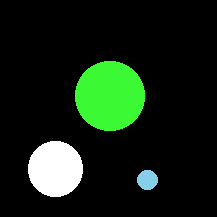
Lagrange Points: L4 or L5?
There are many periodic orbits in the restricted three-body problem.
One of the most famous, discovered by
Lagrange, is formed by an equilateral triangle. The green
sphere represents the Earth, the white one represents the Moon, and
the blue one represents a space station. If the Moon isn't too
heavy, this orbit is thought to be stable: if the space station is pushed a bit
to one side (in position or velocity) it's supposed to make small excursions
around this orbit. The two kinds of triangles (Earth leading or following
Jupiter) are called L4 and L5: these are also called the Trojan points.
There is a group of
enthusiasts who want to set up a colony at the L5 point of the
Earth-Moon system. The folklore in the field says that periodic orbits
are associated with chaotic trajectories. The L5 point
is the most periodic of orbits (ratio of frequencies equal to one).
Clearly, we want to make sure it will be stable!
Questions
- Is the space station at the L4 or the L5 point? One is ahead, and
the other behind.
- The orbit sizes are roughly correct, but we've made the planets huge.
For the Solar system, this was necessary: only the Sun would make a visible
spot with its correct radius. Would making the Earth and Moon the right
radii make the picture nicer? Obviously we'll need to exaggerate the space
station size.
- There is a Lagrange triangle among the moons of
Saturn
.
Helene,
orbits in
Dione's
leading Lagrange point.
Jupiter:
How to Get Jupiter
Jupiter is available
for Windows 95, Windows NT, Macintosh, and several Unix platforms
(the IBM RS6000, Sun Sparc, Dec Alpha (courtesy Kamal Bhattacharya),
Linux, and the PowerPC running AIX4.1).
The files are available without charge by anonymous FTP
(ftp.lassp.cornell.edu) or
via
the World Wide Web.
Last modified: May 19, 1996
James P. Sethna,
sethna@lassp.cornell.edu.
 Statistical Mechanics: Entropy, Order Parameters, and Complexity,
now available at
Oxford University Press
(USA,
Europe).
Statistical Mechanics: Entropy, Order Parameters, and Complexity,
now available at
Oxford University Press
(USA,
Europe).





![]() Statistical Mechanics: Entropy, Order Parameters, and Complexity,
now available at
Oxford University Press
(USA,
Europe).
Statistical Mechanics: Entropy, Order Parameters, and Complexity,
now available at
Oxford University Press
(USA,
Europe).